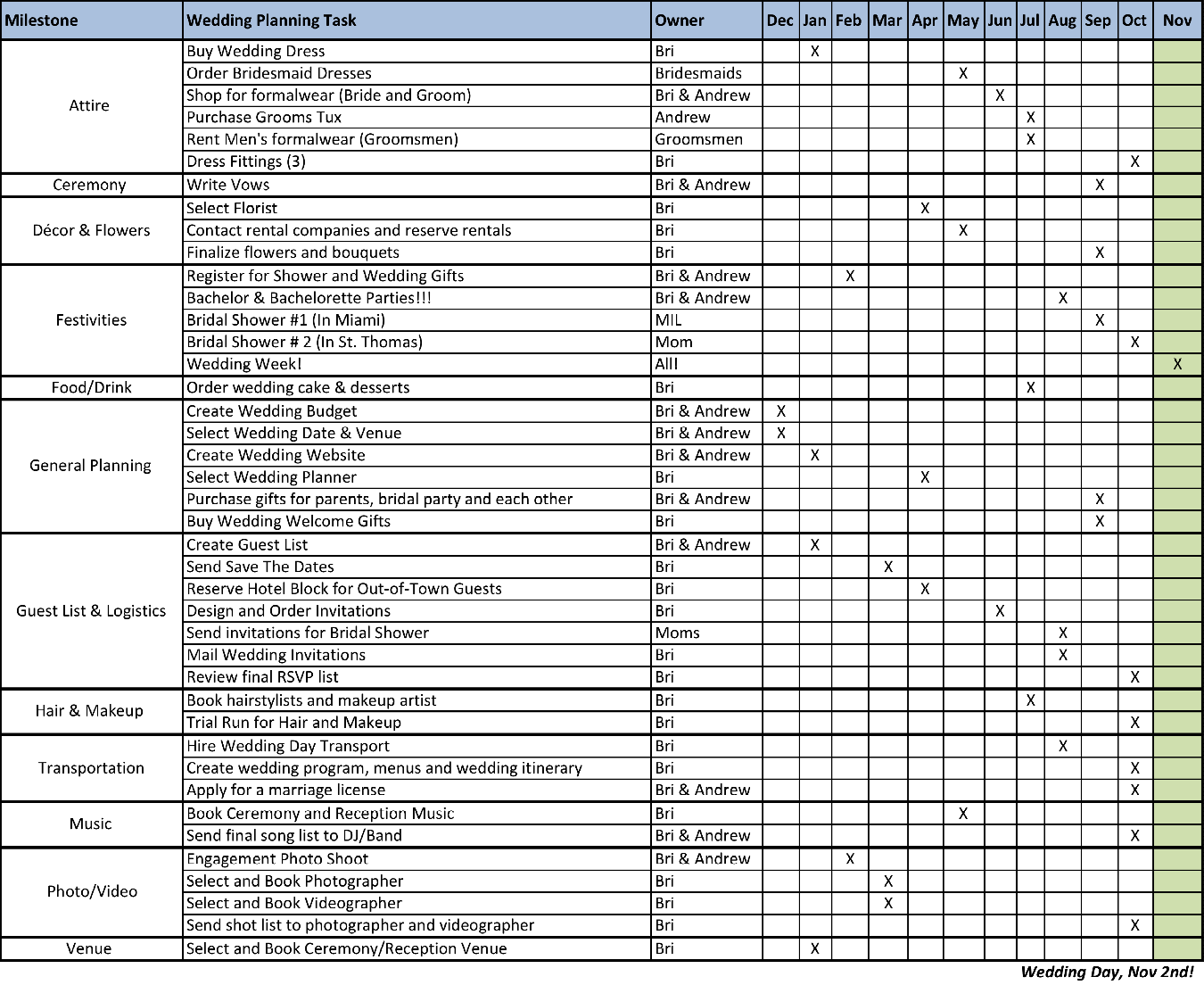How to Plan Your Big Day with a Wedding Timeline

If you are planning a wedding or anything else for that matter, there is ‘something’ that you need to start doing sooner than later. What if I told you this ‘something’ could really help with setting expectations and overall planning?
Would you continue reading? I would hope you would! Any sane person, planning a wedding or not, wants to know how to make their lives more convenient and stress-free; or at least I’d think so.
The Gist of Today’s Post
Is about planning and specifically about using timelines to help you plan, keep track of, and follow through on tasks.
If you’ve been keeping up with my other posts, you’ll know that I am planning a wedding and therefore will be using that as the main example in today’s post. I’ll even share my own wedding timeline.
Due to my job as a project manager, I live and breathe project plans, timelines, and budgets. At this point, I don’t even realize that I subconsciously plan for things in my personal life the same way I do for work-related projects and tasks.
Before You’re Off to the Races…
Let me explain why wedding timelines are so important.
Did you know it takes 6-9 months to make a wedding dress? Were you aware that bridesmaid’s dresses can take up to 5 months to make? Does it surprise you that custom invitations can take up to 2 months?
As a result, I finally figured out why couples remained engaged for over a year!
More on Timelines in Business
Now, project planning is not exclusive to project managers, its applicable to many other areas as well. Project timelines provide a simple visual overview of a project from start to finish and lead to increased work efficiency among individuals and teams.
Because of the benefits of project planning, many professionals use this outside of strict project management roles.

Below are some of the major steps in creating a project plan or timeline. In the following section, I will cover these same steps as it relates to creating a wedding timeline.
While project planning can get very complicated, the below step by step guide gives all the info you need to know.
Step 1: Determine the project goal: This describes what you’re doing and why. It also details out what you plan to produce as a result of the project.
Step 2: Create the project sections: These are the major areas of the project, not tasks but rather buckets of work. For example, if you were remodeling your kitchen, a section of work would be completing the electrical work.
Step 3: Break each major sections into tasks: This represents your to-do list for each major area
Step 4: Determine the total time needed for each task: Estimate the amount of time needed to accomplish each task
Step 5: Identify resource availability & assign tasks: Determine who will do which tasks. Additionally, its best to make sure whoever is assigned agrees with and are excited about the tasks they need to accomplish.
Step 6: Build your project timeline or Gantt Chart: Line up your tasks and reflect the amount of time needed to complete each. Further, a Gantt Chart is the technical term for project schedule or timeline.
And voila, you’ve created a project timeline. Now on to the fun stuff – wedding timelines!
Creating My Wedding Timeline
Let me just start by saying that no matter how much you think you’ve covered it all, ridiculous details and things you haven’t planned for will inevitably bite you in the ass at some point. But the more you plan ahead, the less you will get bitten!

Also, you need to go into this knowing that you WILL NOT be able to please everyone. Just so long as you and your significant other are happy, that’s all that really matters!
How to Start a Wedding Timeline
First, you need to select a date. Then work backward. What I mean by that is that like we discussed above, the wedding is the final goal or objective. Everything in your wedding timeline leads up to that day/weekend.
By following the steps below, rewritten for wedding purposes, you’ll end up creating a wedding timeline or breakdown from today’s date (or whenever you start your planning) through your wedding date. If you’re having a post-wedding brunch like I am, be sure to include that too!
Step 1: Determine the project goal:
To have the most beautiful wedding weekend in St. Thomas USVI and to marry the love of my life surrounded by those nearest and dearest to us!
Step 2: Create the project sections:
The major one is the actual wedding itself but the milestones are the specific categories of planning, such as
Photography and Videography
Food and Drink
Décor & Flowers
Step 3: Break each major sections into tasks:
See below for my wedding timeline, each milestone has associated tasks
Step 4: Determine the total time needed for each task:
See below, each task has a length of time associated with it
Step 5: Identify Resource Availability & Assign
As indicated below, each task on the wedding timeline has an owner assigned… mostly yours truly 😀
Step 6: Build Your Project Timeline or Gantt Chart
Ta Da! See my final wedding timeline below.
Note: if you’re planning a backyard wedding, which at times I’m sorry I’m not doing, you probably do not need the lead time that I mention above. But if you’re even thinking about a destination or larger wedding at a venue, give yourself ample time.
Here is my wedding timeline to date. This is a living document as things change and I am constantly adding to it.

How Granular Should You Get?
That really depends on how detailed you like to be. For things like the day of timeline, you should plan things out by the hour. For example, detail out the time you start your hair and makeup through the sparkler send off. I have yet to complete this but when I do, I’ll be sure to share.
Use it Or Lose It
Steps 1 – 6 detailed below in both business and wedding related scenarios walk you through exactly how to build your very own project timeline or wedding timeline.
Step 1: Determine the project goal.
Step 2: Create the project sections.
Step 3: Break each major sections into tasks.
Step 4: Determine the total time needed for each task.
Step 5: Identify resource availability & assign tasks.
Step 6: Build your project timeline or Gantt chart.
When to Use It
Timeline and project plans are versatile and applicable to many situations. To name a few:
 Events
Events
 Trips
Trips
 Home projects
Home projects
 Childbirth (the 9 months of preparation)
Childbirth (the 9 months of preparation)
 Moving
Moving
 Work Projects
Work Projects
What Do You Think?
 I would love to hear from you if you’ve ever built one yourself. What did you do differently? Additionally, what advice would you share?
I would love to hear from you if you’ve ever built one yourself. What did you do differently? Additionally, what advice would you share?
Wedding timelines should be used when…planning a wedding – DUH! But timelines, in general, can be used when you have a task or goal that has many moving parts and covers a range of time.
Wedding timelines do not have to be as detailed or lengthy as mine but this was meant to give you an idea.
Keep in mind that life happens regardless of how much we plan, and keep priming that pump!
Xoxo Bri
If you enjoyed this post, it would mean the world to us if you shared it via any of the social media platforms below!
Popular Previous Posts:
What You Need to Do to Achieve Life Balance
How to Use An Exit Strategy to Win at Life
This is Why You Need an Advisory Board of Amazing Mentors for Your Life
Timing is Everything – The Best Time to Do Things
How to Make Life Easier With These 2 Accounting Methods
How to Clear Your Mind and Get Out of Your Head
One Thing You Can Do Every Day That Will Improve Your Life
References
https://www.lucidchart.com/blog/8-steps-to-build-a-project-management-timeline


Great comments Dave! You never cease to surprise me with your experiences – that “wallpaper chart” sounds epic!
Tried to stay away from the technicalities for the purposes of this post and for wedding planning 🙂
Best,
Bri
Who wudda thunk it? I have not heard the words Gantt Chart in almost 10 years. We used them all the time in the aerospace industry. Our operations division employed a full-time scheduler just to prepare and maintain the timelines. There are computer routines that allow you to input your estimated timelines and then build the Gantt for you to print out.
One thing that you must identify on the chart is called the Critical Path. To determine the path, work backwards from the end goal. The critical path identifies serial tasks, that is to say ‘before Task D can start, Task C must be completed’. Tasks A, B, and E can run in parallel. Do this for the whole project, and given the end date, the CP will define the start date. If a task on the critical path is taking longer than expected, you have to adjust – more manpower, more funds, or the last resort which is to extend the completion date. The way around this – pre-position in the schedule some “slop time” for contingencies. In a past life, I have created a Gantt Chart on a project for preparing a satellite for launch on the space shuttle in the 1990’s. The chart ran 27 linear pages, which were printed out on dot-matrix fan fold paper. I nicknamed it the “wallpaper chart”, because I taped it to the wall in the conference room, and it stretched around a corner. Everybody wanted their own copy – the government program office, upper corporate management, the systems engineering people…..well you get the idea.
Your Gantt won’t be anywhere near as complicated. While ours ended in Smoke and Flames as the shuttle launched, yours will end with a simple two word sentence – – I Do.